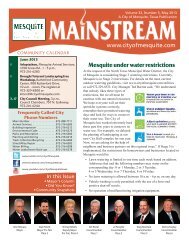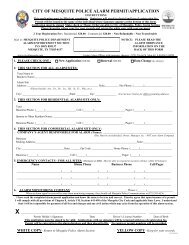airport/documents/Mesquite Master Plan Final.pdf - The City of ...
airport/documents/Mesquite Master Plan Final.pdf - The City of ...
airport/documents/Mesquite Master Plan Final.pdf - The City of ...
Create successful ePaper yourself
Turn your PDF publications into a flip-book with our unique Google optimized e-Paper software.
TABLE 3K<br />
Taxiway Design Standards<br />
<strong>Mesquite</strong> Metro Airport<br />
Airplane Design Group<br />
Group II (49' to 79' wingspan) Group III (79' to 118' wingspan)<br />
Taxiway Width (ft.) 35 50<br />
Shoulder Width (ft.)<br />
Object Free Area (ft.)<br />
10 20<br />
Taxiway OFA 131 186<br />
Taxilane OFA<br />
Separation Distances (ft.)<br />
115 162<br />
Taxiway Centerline to Object 65.5 93<br />
Taxilane Centerline to Object 57.5 81<br />
Source: FAA AC 150/5300-13, Airport Design, Change 8<br />
NAVIGATIONAL AIDS AND<br />
INSTRUMENT APPROACHES<br />
Airport and runway navigational aids<br />
are based on FAA recommendations, as<br />
defined in DOT/FAA Handbook<br />
7031.2B, Airway <strong>Plan</strong>ning Standard<br />
Number One, FAA Advisory Circular<br />
150/5300-2D, Airport Design<br />
Standards, Site Requirements for<br />
Terminal Navigation Facilities, and<br />
TxDOT’s Policies and Standards.<br />
Navigational aids provide two primary<br />
services to <strong>airport</strong> operations: precision<br />
guidance to specific runway and/or nonprecision<br />
guidance to a runway or the<br />
<strong>airport</strong> itself. <strong>The</strong> basic difference<br />
between a precision and non-precision<br />
navigational aid is that the former<br />
provides electronic descent, alignment<br />
(course), and position guidance, while<br />
the non-precision navigational aid<br />
provides only alignment and position<br />
location information; no elevation<br />
information is given. <strong>The</strong> necessity <strong>of</strong><br />
such equipment is usually determined<br />
by design standards predicated on<br />
safety considerations and operational<br />
needs. <strong>The</strong> type, purpose, and volume<br />
<strong>of</strong> aviation activity expected at the<br />
3-22<br />
<strong>airport</strong> are factors in the determination<br />
<strong>of</strong> the <strong>airport</strong>’s eligibility for<br />
navigational aids.<br />
Global Positioning System<br />
<strong>The</strong> advancement <strong>of</strong> technology has<br />
been one <strong>of</strong> the most important factors<br />
in the growth <strong>of</strong> the aviation industry in<br />
the second half <strong>of</strong> the twentieth<br />
century. Much <strong>of</strong> the civil aviation and<br />
aerospace technology has been derived<br />
and enhanced from the initial<br />
development <strong>of</strong> technological<br />
improvements for military purposes.<br />
<strong>The</strong> use <strong>of</strong> orbiting satellites to confirm<br />
an aircraft’s location is the latest<br />
military development to be made<br />
available to the civil aviation<br />
community.<br />
Global positioning systems (GPS) use<br />
three or more satellites to derive an<br />
aircraft’s location by a triangulation<br />
method. <strong>The</strong> accuracy <strong>of</strong> these systems<br />
has been remarkable, with initial<br />
degrees <strong>of</strong> error <strong>of</strong> only a few meters.<br />
As the technology improves, it is<br />
anticipated that GPS may be able to<br />
provide accurate-enough position




